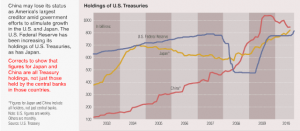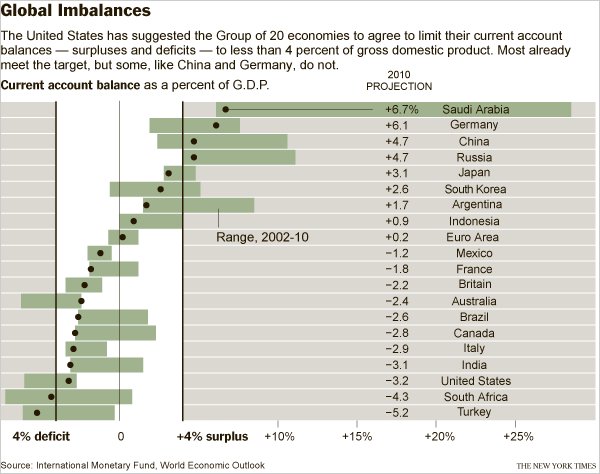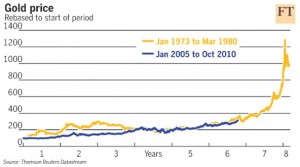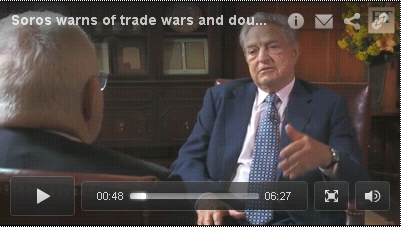Under water…
The under-water map of the US mortgages by states.
The Fed is set to surpass China…
The Fed is set to replace China as the largest holder of the US treasuries.
(source: Bloomberg)
Chinese government does not have much choice here. It can’t ditch dollar – that’s the only international reserve currency today, probably the safest one in time of crisis; It can’t buy gold, not much. Otherwise, it will push up gold price dramatically. It can’t buy high-growth currencies, like Aussie dollar or Brazilian real, either: the appreciation of these currencies will make China’s imports of natural resources more expensive.
Chinese central bank is left with roughly three choices:
1) buy assets denominated in Euro and Yen – Germans and Japanese then won’t be happy because now every country seems to have adopted a “beggar-thy -neighbor” policy, trying to increase exports through currency devaluation.
2) buy hard assets, such as oil, gas and mines – that’s what China had been doing. But this is likely to stir a lot of nationalism – Nobody likes such government-led big purchase of its own natural resources, especially this government is led by a Communist Party.
3) equity investment in or partnership with good-solid companies. Companies like Warren Buffet’s Berkshire Hathaway, Goldman Sachs, JP Morgan, Coca-cola, HP, etc…these solid blue chip companies with diversified international portfolio.
In the long term, China should work on designing an alternative international monetary system – a system not based on any paper currency of a single country.
Gold bubble forming
I have been bullish on gold since I expected the Fed could never get the timing of exit (from the current easy monetary policy) right.
With another round of money-printing or QE2 from the Fed, gold price has been soaring in recent weeks. FT compares the surge of gold to the past asset bubbles. The crude comparison seems to indicate that gold is now in its early bubble-forming stage.
(click on the graph to play)
Like every asset bubble, the time of reckoning will eventually come. It’s fool’s game trying to get the timing right, however.
Now it has become more clear that the Fed’s super easy monetary policy is in the process of creating at least two bubbles in the world – first the gold, second is the bubble in emerging markets – remind me of Latin America crisis in 1990s.
George Soros on Chinese currency
(click to play; source: FT)
Here is the related FT article:
The prevailing exchange rate system is lopsided. China has essentially pegged its currency to the dollar while most other currencies fluctuate more or less freely. China has a two-tier system in which the capital account is strictly controlled; most other currencies don’t distinguish between current and capital accounts. This makes the Chinese currency chronically undervalued and assures China of a persistent large trade surplus.
It is no exaggeration to say that since the financial crisis, China has been in the driver’s seat. Its currency moves have had a decisive influence on exchange rates. Earlier this year when the euro got into trouble, China adopted a wait-and-see policy. Its absence as a buyer contributed to the euro’s decline. When the euro hit 120 against the dollar China stepped in to preserve the euro as an international currency. Chinese buying reversed the euro’s decline.
…
Whether it realises it or not, China has emerged as a leader of the world. If it fails to live up to the responsibilities of leadership, the global currency system is liable to break down and take the global economy with it. Either way, the Chinese trade surplus is bound to shrink but it would be much better for China if that happened as a result of rising living standards rather than a global economic decline.
Fed Boston Summit
First interview with Boston Fed President Eric Rosengren.
His main message I took away is, “with nominal interest rate fixed (near zero level), disinflation would be monetary tightening. Deflation would be even worse”. This offers enough reason for further monetary easing.
Also, one lesson learned from Japan was that monetary policy under “liquidity trap” should be proactive. The Fed’s monetary easing can’t afford to be nearly as gradual as Japan.
Second interview with John Taylor. According to Taylor Rule, current interest rate should be at .75%. He is not in favor of QE2.
The last interview with Jim Hamilton on how the Fed might affect long term interest rate through bond purchase.
Emerging markets – the next bubble
NYT on the next asset bubbles.
It seems premature to start worrying about the next financial crisis. Yet amid the current gloom, Wall Street is snapping up assets of the “emerging economies” that are growing faster and offer higher, more consistent returns. Financial regulators and policy makers in these countries need to pay close attention.
The Institute of International Finance, which lobbies for big banks, estimates that $825 billion will flow into developing countries this year, 42 percent more than in 2009. Investments in debt of emerging economies alone is expected to triple, to $272 billion.
While developing countries often benefit from foreign investments, huge inflows of capital complicate their macroeconomic management. They push up the value of their currency, boosting imports and slowing exports, and they promote fast credit expansion — which can cause inflation, inflate asset bubbles and usually leave a pile of bad loans. This money turns tail at the first sign of trouble, tipping countries into crisis.
Those are the dynamics behind Mexico’s 1994 “tequila crisis,” the 1997 Asian crisis, the 1998 Russian catastrophe, the 1999 Brazilian debacle and the 2002 Argentine collapse. The housing bubble that burst here in 2008 was painfully similar, with irrational investments and then a sudden flight.
A collapse in emerging market bonds would further damage the weak balance sheets of American banks. Still, it is not time to panic. Developing countries are in relatively good economic shape, while interest rates in the wealthy countries are likely to stay low for years. Yet the financial system remains fragile. And a shock — say a default in Ireland or Greece — could prompt a fast U-turn away from emerging markets.
There is little policy makers in the rich world can do to stop these flows. Governments in the developing world must prepare now for when the money masters change their minds.
That means they cannot let their budgets get out of hand. And they have to keep a very close eye on their own banks. This might also be a good time to consider capital controls to slow inflows. Chile managed them successfully in the 1990s. Even the International Monetary Fund — long a foe of anything that got in the way of money — acknowledged this year that controls should be part of the toolkit.
Americans sour on trade
The American public, already skeptical of free trade, is becoming increasingly hostile to it.
In the latest Wall Street Journal/NBC News poll, more than half of those surveyed, 53%, said free-trade agreements have hurt the U.S. That is up from 46% three years ago and 32% in 1999. Even Americans most likely to be winners from trade—upper-income, well-educated professionals, whose jobs are less likely to go overseas and whose industries are often buoyed by demand from international markets—are increasingly skeptical.![[TRADEfrt]](https://sg.wsj.net/public/resources/images/P1-AX492A_TRADE_NS_20101003231621.gif)
"The important change is that very well-educated and upper-income people compared to five to 10 years ago have shifted their opinion and are now expressing significant concern about the notion of…free trade," said Bill McInturff, a Republican pollster who helps conduct the Journal survey. Among those earning $75,000 or more, 50% now say free-trade pacts have hurt the U.S., up from 24% who said the same in 1999.







![[TRADEjmp]](https://sg.wsj.net/public/resources/images/P1-AX493A_TRADE_NS_20101003193633.gif)